| Pages:
1
2 |
Neuraxial
Oud Lover
 
Posts: 18
Registered: 5-18-2020
Member Is Offline
|
|
Lavta, Anyone?
Having played the oud for a number of years, I've only recently begun to notice the lavta and its unique place in the Anatolian musical tradition. Now
I recently received one as a gift, quite coincidentally, and I am intrigued.
There does not seem to be a lot of talk on it though. There is much less information to be found than on the oud, which seems to have become almost
something of a mainstream instrument!
I came across this promising thread that unfortunately did not take off:
http://www.mikeouds.com/messageboard/viewthread.php?tid=17082#pid11...
Shall we try again?
Anyone here play lavta? What kind of strings do use (or recommend using)? What tunings? Who made your lavta?
Given the possibility that the ancient ancestor of the oud may have been a fretted instrument (as most ancient lutes seemed to have been), isn't it
interesting that a "new" instrument (such as the lavta was, then) brought the oud design closer to antiquity?
There is no comparable nylon strung instrument today: all the other fretted (Anatolian) lutes (saz, etc) have steel strings.
Sure, there is always the tanbur, but the lavta, with its shorter neck and small oud-like body is so much more practical and elegant.
How is this not a more popular instrument?
happy to hear your thoughts on it!
Edit: also, if you have one, show us some photos!
Edit 2: I'll kick off with the photos 
 s-l1600 by A.L. Papazoglu, on Flickr s-l1600 by A.L. Papazoglu, on Flickr
 s-l1600 (1) by A.L. Papazoglu, on Flickr s-l1600 (1) by A.L. Papazoglu, on Flickr
|
|
|
Sabah9
Oud Admirer

Posts: 7
Registered: 2-9-2021
Member Is Offline
|
|
I just started studying Ottoman Classical music and I bought a lavta! I am super excited and I love this instrument. I bought it from Baris Karatekeli
but haven't received it yet 
I would love to know as much as possible about lavta, but indeed I haven't found much online.
Do you maybe know if there is a method book or smth to help beginners?
Thank you 
|
|
|
majnuunNavid
Oud Junkie
    
Posts: 622
Registered: 7-22-2013
Member Is Offline
Mood: Dude, where's my Oud?
|
|
I have to agree. I don't know why the lavta is not more popular. It's way easier to start playing than Oud since you have frets.
But it's rather comparable in form to Turkish Tambur, Persian Tar, and Lebanese Buzuk in my opinion.
I was very close to adding one to my collection too. Maybe I should have.
|
|
|
dusepo
Oud Junkie
    
Posts: 107
Registered: 2-6-2021
Location: London, Britain
Member Is Offline
Mood: Dastgah-e Chahargah ?????? ???????
|
|
I have a lavta, though to my shame I rarely play it lately!
I've come to find the frets on a lavta somewhat limiting. I know they are movable, but you have to move them, and they are, as standard, set to
Turkish quarter tones, which are different from Arabic and Persian/Iranian.
To answer your question about strings, I use the top 4 courses of an oud set.
|
|
|
Sabah9
Oud Admirer

Posts: 7
Registered: 2-9-2021
Member Is Offline
|
|
Here's mine. Still in process 
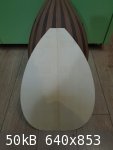
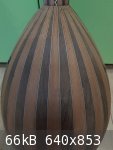
|
|
|
vidiakas
Oud Lover
 
Posts: 11
Registered: 10-21-2013
Member Is Offline
|
|
Hi all,
I am a happy owner of a Baris Yekta lavta - actually bought through this forum. It was used professionally in Istanbul, so lots of marks etc, but
sound-wise it is an incredible instrument. On top of the maker skills, it seems that heavy use really made its sound unfold.
Strings wise, I use normal Turkish oud strings (2nd to 4th pairs and an extra 5th for the bass single). I would love to experiment with metal strings
but given the much higher tension, I will not do it unless I am sure it can handle it. It's the same mistake that has destroyed lots of classical
guitars. Some makers (like Dimitris Rapakousios) do it but they definitely know what they put on, plus that I suspect they might brace the instrument
more heavily.
Now on lavta playing, this instrument is strangely confusing most people I know. Oud players are not quite used to frets, less strings and the longer
neck, while mandolin or bouzouki players get confused by the different tuning and most of all, the many frets on the board. IMHO, the best instrument
to train you on lavta is either baglama saz or (less) the Greek steel-string lute (and also Turkish tambur? - don't know). So that you get accustomed
to the frets (saz) and to a style of playing that is equally vertical and horizontal (lute). During playing, I have found particularly applicable the
saz-like use of thumb (i.e. for an E ussak song) and the use of fifth-chords accompaniment (like in Greek lutes).
Last, on tuning, DAda is the norm and I quite like it - however, DGda is also making sense as it is more versatile in terms of drone open strings -
particularly helpful for Greek repertoire. CGda is also nice and close to a lute tuning, even though it differs due to C low bass string (in a Greek
mainland lute it would be cGda). Next project is experimentation with string arrangements - gDae (as a Cretan lute) might be also good. One more area
where experience with baglama saz is helpful, as this instrument has a hell of a lot of different tunings and string arrangements, while oud and lavta
are apparenly more standardized.
At any case, it is a hell of an instrument IMHO, quite versatile and sort of unifying all eastern Mediterranean traditions in a single instrument. No
mass production though means that you have to pay a good amount of money for a decent instrument to start exploring it, but it definitely deserves
more attention.
|
|
|
vidiakas
Oud Lover
 
Posts: 11
Registered: 10-21-2013
Member Is Offline
|
|
And here's the baby. As you can see, it has less frets than a usual lavta - this is coming from the previous owner and honestly, I don't see the need
for more. :-)
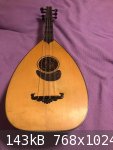
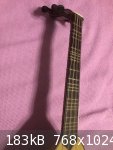
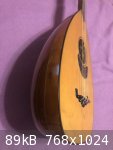
|
|
|
Sabah9
Oud Admirer

Posts: 7
Registered: 2-9-2021
Member Is Offline
|
|
This looks beautiful!
May I ask for more info on the CGda being more appropriate for Greek repertoire? What is the difference between the Greek and the Turkish repertoire
(if any)?
|
|
|
vidiakas
Oud Lover
 
Posts: 11
Registered: 10-21-2013
Member Is Offline
|
|
Oh well, there is not a single, uniform Greek or Turkish repertoire - huge regional variations within the countries, so even bigger between the two
countries. Then again, we at the same time share quite a lot of things, from instruments to songs to scales. Esp. in neighboring areas (i.e. Aegean
islands close to the Asia Minor coast and the Asia Minor coast itself), it is safe to say that the music is practically the same - it is only the
language that differs.
(To give you an idea of regional variations, even on just the Greek lute (steel string), there are two different tunings, cGda for mainland and island
folk music and gDae for Cretan folk music. So go figure... :-) )
On the tuning, I should have said that DGda is good particularly for Cretan folk music, to be more precise: lots of tunes from D and G, less from A
and E. And usually, these tunes alternate in a sequence of songs (that can last forever), so you need to transpose but at the same time to fill your
playing with either chords (5's or, rarely, major) or (more often) open strings.
So, given this need, I personally find this tuning more versatile than DAda where, for example, to play a G major scale tune (a rast or segah, of
sorts), I don't have an open G. Or, for an E-ussak tune, an open G can give a nice G major chord "feel" before descending to the tonic (quite common
in Cretan folk music). On the contrary, would prefer DAda for rembetiko (urban early 20th century Greek music), as it resembles the old bouzouki
tuning (DAd) and it can really work wonders in this repertoire.
|
|
|
Sabah9
Oud Admirer

Posts: 7
Registered: 2-9-2021
Member Is Offline
|
|
Thank you for this. I am Greek but I've only started studying these music traditions. Do you maybe know if there is a method for lavta?
|
|
|
vidiakas
Oud Lover
 
Posts: 11
Registered: 10-21-2013
Member Is Offline
|
|
I am not aware of any method in Greek or English - in Turkish, there are plenty though. Meanwhile, Youtube will be on your side. :-) For instance:
https://www.youtube.com/watch?v=hgs6362y8SA
|
|
|
Sabah9
Oud Admirer

Posts: 7
Registered: 2-9-2021
Member Is Offline
|
|
That's awesome! Thanks so much!
|
|
|
dario
Oud Maniac
   
Posts: 55
Registered: 3-27-2014
Member Is Offline
|
|
A friend who plays lavta told me that there is no known 'traditional' playing technique - the lavta was quite geographically restricted (being only
found in Istanbul and, even then, mostly played by non-Muslims) and was mostly forgotten for the first half of the 20th century so very few recordings
from old masters survive (2 Cemil Bey taksims for example). As a result, current playing technique is borrowed from other instruments, particularly
oud and tanbur. I find surprising that it isn't played like a laouto (combination of melodic runs and chordal accompaniment), even though on the
surface that would appear to be its closest relative among popular instruments of the region.
If anyone has any information on how and when the revival came about that would be very interesting!
|
|
|
adamgood
Oud Junkie
    
Posts: 499
Registered: 6-27-2005
Location: Brooklyn, NY
Member Is Offline
Mood: 2.7 koma flat
|
|
Dario, you get one more from Tanburi Cemil Bey, he plays lavta on a Rast Gazel:
https://www.youtube.com/watch?v=KxdPX9gQzfw
It really is too bad we don't have more recordings of lavta from the beginning of the 20th century. I can't think of any more beyond Cemil Bey.
Looking at divanmakam.com I come up with these composers known as lavatcı:
Ahmet Bey
Andon - we play many of his compositions
Civan Ağa - Ama, Lavtacı, Zivanis
Galib Bey - Binbaşı, Lavtacı
Hristo - Hanende, Lavtacı İ think he's from the same family as Andon?
Ovrik Kazasyan - Lavtacı
Tahsin Bey- Lavtacı, Yüzbaşı
Hristo and Andon died right around the time it would have been possible to record them.
|
|
|
adamgood
Oud Junkie
    
Posts: 499
Registered: 6-27-2005
Location: Brooklyn, NY
Member Is Offline
Mood: 2.7 koma flat
|
|
Quote: Originally posted by dario  | I find surprising that it isn't played like a laouto (combination of melodic runs and chordal accompaniment)
|
My understanding is kemençe (Istanbul lyra) and lavta were the combo among Greeks around Constantinople in the late 1800s and was an instrument basis
for Köçekçeler type repertoire. WHAT did that sound like?? If only we could hear it. Could be wrong but I have it in my mind that Cretan style lyra
and laouto would be a direct descendant of this? Not so much in terms of repertoire but in terms of instrument and function like you're mentioning
above, especially in Cretan music the laouto moves effortlessly between "chordal" (more like rhythmic) accompaniment and playing unison melody.
|
|
|
dario
Oud Maniac
   
Posts: 55
Registered: 3-27-2014
Member Is Offline
|
|
Quote: Originally posted by adamgood  | Quote: Originally posted by dario  | I find surprising that it isn't played like a laouto (combination of melodic runs and chordal accompaniment)
|
My understanding is kemençe (Istanbul lyra) and lavta were the combo among Greeks around Constantinople in the late 1800s and was an instrument basis
for Köçekçeler type repertoire. WHAT did that sound like?? If only we could hear it. Could be wrong but I have it in my mind that Cretan style lyra
and laouto would be a direct descendant of this? Not so much in terms of repertoire but in terms of instrument and function like you're mentioning
above, especially in Cretan music the laouto moves effortlessly between "chordal" (more like rhythmic) accompaniment and playing unison melody.
|
It's a tantalising thought for sure! I don't know enough about the history of Cretan music to speculate. The closest thing I have come across to what
you describe in recorded repertoire is some insane strummy playing from Yorgo Bacanos (see 22:49 here https://www.youtube.com/watch?v=NMyY9QOZSLk ) which sounds very 'island' style, especially with how the violin comes in leading the band. Or
perhaps old-time lavtacis played like this and he learned it from them?
|
|
|
Sabah9
Oud Admirer

Posts: 7
Registered: 2-9-2021
Member Is Offline
|
|
If indeed lavta and laouto are connected, how did lavta lose the microtones do you think?
|
|
|
dusepo
Oud Junkie
    
Posts: 107
Registered: 2-6-2021
Location: London, Britain
Member Is Offline
Mood: Dastgah-e Chahargah ?????? ???????
|
|
If the laouto did come from the lavta and lost it's microtonal frets, it would be just like the buzuq > bouzouki and baglama > baglamadaki.
From what I've read before, the lavta went out of fashion and got replaced by the oud in it's role, rather than the laouto.
|
|
|
dario
Oud Maniac
   
Posts: 55
Registered: 3-27-2014
Member Is Offline
|
|
Quote: Originally posted by dusepo  |
If the laouto did come from the lavta and lost it's microtonal frets, it would be just like the buzuq > bouzouki and baglama > baglamadaki.
From what I've read before, the lavta went out of fashion and got replaced by the oud in it's role, rather than the laouto. |
I thought the laouto was descended from Italian instruments of the mandolin family (which, of course, are ultimately descended from the oud by way of
Spain!)...If that is the case the laouto (and bouzouki) are the offspring of quite an incestuous fusion of cousins from East and West.
|
|
|
DivanMakam
Oud Addict
  
Posts: 41
Registered: 4-28-2015
Member Is Offline
|
|
Quote: Originally posted by adamgood  |
Dario, you get one more from Tanburi Cemil Bey, he plays lavta on a Rast Gazel:
https://www.youtube.com/watch?v=KxdPX9gQzfw
It really is too bad we don't have more recordings of lavta from the beginning of the 20th century. I can't think of any more beyond Cemil Bey.
Looking at divanmakam.com I come up with these composers known as lavatcı:
Ahmet Bey
Andon - we play many of his compositions
Civan Ağa - Ama, Lavtacı, Zivanis
Galib Bey - Binbaşı, Lavtacı
Hristo - Hanende, Lavtacı İ think he's from the same family as Andon?
Ovrik Kazasyan - Lavtacı
Tahsin Bey- Lavtacı, Yüzbaşı
Hristo and Andon died right around the time it would have been possible to record them.
|
There are a lot more who played the lavta. Right now we are preparing our Wiki by going through biographies to collect a big list.
At the end every instrument will have its own page and on that page you will find the list of composers who played those instruments. Not every time a
played instrument can be found in the nickname. 2500+ composers to go through, so it will take a while.
There will be a lot more other useful pages. I will announce it on here, too, when we are finished.
Yes, Hristo, Civan and Andon were 3 brothers. They also raised Vasil the kemenche player who supported them financially later on.
Sadly, I think one reason we don't have many recordings of them is because when vinyls started to became popular, we had the great wars during that
time and then the population exchange between both countries happened. So when everything was settled in, it was never the same again. Having also a
ban on Turkish music didn't help either during Atatürk's time. We never recovered from all those wars culturally speaking. An Empire collapsed, and
nationalism became a thing in Europe and let our own people to turn against us. We lost our great culture among our friends and neighbours. I wish it
would have been differently but too late now.
If our site gets big enough and I hope one day we can also have English Wiki pages for the stuff we will write and prepare. The plan is to have
explanations for all of our makams and forms and usuls with examples of course. And same for our instruments, which lavta is one of them. Maybe in 2-3
years I can come back and talk about it, who knows.
|
|
|
Sabah9
Oud Admirer

Posts: 7
Registered: 2-9-2021
Member Is Offline
|
|
This sounds amazing. Is it you personally that's undertaking this endeavour? I would love to help.
|
|
|
DivanMakam
Oud Addict
  
Posts: 41
Registered: 4-28-2015
Member Is Offline
|
|
Any help is welcome. You can visit our website and see for yourself how our site is built and pm me if you are interested in helping. It is a big task
so you shouldn't underestimate it. I assume you speak Turkish which would be needed.
Our team consists of 5 people + me. So I am thankfully not alone in this. It just takes so much time. We also upload new sheet music to our system
regularly, so you visitors have many versions for each piece to choose from.
Our goal is to have basic biographic information about each person on our system (currently above 7000+ people). We started with composers and will
move later to lyricists/poets. And then go to the other stuff like makams, usûls and forms which will be the next big step.
|
|
|
adamgood
Oud Junkie
    
Posts: 499
Registered: 6-27-2005
Location: Brooklyn, NY
Member Is Offline
Mood: 2.7 koma flat
|
|
DivanMakam!
It's so nice to see you here. I use your site EVERY DAY for looking up notation for makam music. It's incredible.
This is great, the goal to have biographies for everyone. I'm eager to see how it's structured and to learn more about musicians, including the
lavtacıs. Thank you for the reminder of the great family of lavta musicians. Vasilaki supported them financially...I'm interested to hear more
about this.
Adam
|
|
|
DivanMakam
Oud Addict
  
Posts: 41
Registered: 4-28-2015
Member Is Offline
|
|
Quote: Originally posted by adamgood  | DivanMakam!
It's so nice to see you here. I use your site EVERY DAY for looking up notation for makam music. It's incredible.
This is great, the goal to have biographies for everyone. I'm eager to see how it's structured and to learn more about musicians, including the
lavtacıs. Thank you for the reminder of the great family of lavta musicians. Vasilaki supported them financially...I'm interested to hear more
about this.
Adam |
Thank you for your kind words.
We have so many names in the system, and many people with the same name. So it gets confusing to know who is who and to separate people we started
very recently to add biographic information, at least like when someone was born or died, if we can find such information.
As an example page from Hristo: https://divanmakam.com/forum/hristo-hanende-lavtaci-1914.63567/
As you see we have added 16 tags. Each person in our system has his own page. On his own page you will be able to see photos about that person, his
biographic tags, and if possible a biography and other similar text (like on Wikipedia) and at the end his works.
I didn't have the time to translate our tags yet, but the 16 tags are:
1. Name (nickname and variations)
2. Birthday and month
3. Birthyear
4. Birthplace
5. Deathday and month
6. Deathyear
7. Place of grave
8. Connection to music (like was he a composer, a poet, which instrument did he play, was he a teacher, etc.)
9. Other occupations (like outside of music, maybe a Sultan, a preacher, a doctor, etc.
10. Other features
11. Place of living
12. Century
13. Native language
14. Teachers
15. Students
16. Family members and friends.
See, all of the entered things will have their own pages, too. So, like any birthday will have its own page. With 1 click you will be able to see who
else was born on that same day, or died at that day. Or who else played tanbur or lavta. Or who else is a doctor, etc.
There are not much info about these people sadly. If you read Turkish, you could find some information in books. Vasilaki entered the club of
Lavtacı Andon and he was a supreme Kemenche player. It is said that Cemil Bey regarded him as the best Kemenche player. So he was a famous
musician and played a lot in the Ottoman court and in that society. Also a statesperson supported him. He learned Turkish Music from the Lavtacı
brothers, so I guess as appreciation he supported them back during his lifetime. At least that is told. Later when he died those brothers had
financial problems. And sadly the youngest brother Hristo commited suicide (it is also believed he had mental health issues).
|
|
|
ChanningPDX
Oud Maniac
   
Posts: 96
Registered: 10-15-2016
Member Is Offline
|
|
Hi, all!
I thought I'd resurrect this thread since I recently acquired a lâvta myself, and I'm sure there are a few other closet lâvta lurkers on the
forum.
Mine is a Kamil Gül lâvta pretty much identical to the one Nexurial posted at the top of the thread but with a wenge bowl.
I also have an oud from Kamil, and they're both pretty well made and good sounding instruments for the money. In the case of the lâvta, I found it
for sale from a used music shop in Colorado for $400--half the price it was going for new at Ethnic Musical (which is where I suspect it originally
came from), so I think I got a pretty good deal.
I'm still playing in DAda tuning, which I'll probably stick to for the time being. Playing in makams like Rast and Segâh is lots of fun, but as
others have commented, certain tunes that are relatively straightforward to play on the oud don't come as easily to the lâvta thanks to the longer
neck and tuning in fifths rather than fourths. I can see why some lavtâ players play the meyhane parts of certain tunes (such as "Nikriz Longa") down
an octave...
Enver Mete Aslan recently published a lâvta method. It's in Turkish only, but the musical examples are pretty self-explanatory.
https://www.hepsiburada.com/istanbul-lavtasi-metodu-enver-mete-aslan...
I was able to find another lâvta method that I like even better written by Kerem Güney and posted for free on the Internet, which I've linked to
below for anyone interested.
https://www.scribd.com/doc/297769632/385604-pdf
I'd love to hear more from other lâvta players on the forum about your experiences learning, favorite pieces to play, etc. It certainly seems like
there's a lot of potential for alternate melody and backing sorts of playing. It also seems to me that a lâvta tuned CGcg might work pretty well for
playing Persian music. Has anyone else ever tried that?
|
|
|
| Pages:
1
2 |